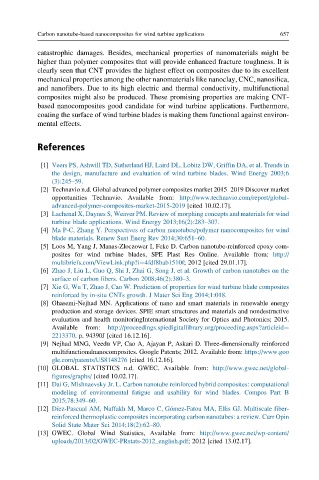Page 714 - Polymer-based Nanocomposites for Energy and Environmental Applications
P. 714
Carbon nanotube-based nanocomposites for wind turbine applications 657
catastrophic damages. Besides, mechanical properties of nanomaterials might be
higher than polymer composites that will provide enhanced fracture toughness. It is
clearly seen that CNT provides the highest effect on composites due to its excellent
mechanical properties among the other nanomaterials like nanoclay, CNC, nanosilica,
and nanofibers. Due to its high electric and thermal conductivity, multifunctional
composites might also be produced. These promising properties are making CNT-
based nanocomposites good candidate for wind turbine applications. Furthermore,
coating the surface of wind turbine blades is making them functional against environ-
mental effects.
References
[1] Veers PS, Ashwill TD, Sutherland HJ, Laird DL, Lobitz DW, Griffin DA, et al. Trends in
the design, manufacture and evaluation of wind turbine blades. Wind Energy 2003;6
(3):245–59.
[2] Technavio n.d. Global advanced polymer composites market 2015–2019 Discover market
opportunities Technavio. Available from: http://www.technavio.com/report/global-
advanced-polymer-composites-market-2015-2019 [cited 10.02.17].
[3] Lachenal X, Daynes S, Weaver PM. Review of morphing concepts and materials for wind
turbine blade applications. Wind Energy 2013;16(2):283–307.
[4] Ma P-C, Zhang Y. Perspectives of carbon nanotubes/polymer nanocomposites for wind
blade materials. Renew Sust Energ Rev 2014;30:651–60.
[5] Loos M, Yang J, Manas-Zloczower I, Feke D. Carbon nanotube-reinforced epoxy com-
posites for wind turbine blades, SPE Plast Res Online. Available from: http://
multibriefs.com/ViewLink.php?i¼4fdf8bab1510f; 2012 [cited 29.01.17].
[6] Zhao J, Liu L, Guo Q, Shi J, Zhai G, Song J, et al. Growth of carbon nanotubes on the
surface of carbon fibers. Carbon 2008;46(2):380–3.
[7] Xie G, Wu T, Zhao J, Cao W. Prediction of properties for wind turbine blade composites
reinforced by in-situ CNTs growth. J Mater Sci Eng 2014;1:018.
[8] Ghasemi-Nejhad MN. Applications of nano and smart materials in renewable energy
production and storage devices. SPIE smart structures and materials and nondestructive
evaluation and health monitoringInternational Society for Optics and Photonics; 2015.
Available from: http://proceedings.spiedigitallibrary.org/proceeding.aspx?articleid¼
2213370. p. 94390J [cited 16.12.16].
[9] Nejhad MNG, Veedu VP, Cao A, Ajayan P, Askari D. Three-dimensionally reinforced
multifunctionalnanocomposites. Google Patents; 2012. Available from: https://www.goo
gle.com/patents/US8148276 [cited 16.12.16].
[10] GLOBAL STATISTICS n.d. GWEC. Available from: http://www.gwec.net/global-
figures/graphs/ [cited 10.02.17].
[11] Dai G, Mishnaevsky Jr. L. Carbon nanotube reinforced hybrid composites: computational
modeling of environmental fatigue and usability for wind blades. Compos Part B
2015;78:349–60.
[12] Dı ´ez-Pascual AM, Naffakh M, Marco C, Go ´mez-Fatou MA, Ellis GJ. Multiscale fiber-
reinforced thermoplastic composites incorporating carbon nanotubes: a review. Curr Opin
Solid State Mater Sci 2014;18(2):62–80.
[13] GWEC. Global Wind Statistics, Available from: http://www.gwec.net/wp-content/
uploads/2013/02/GWEC-PRstats-2012_english.pdf; 2012 [cited 13.02.17].

